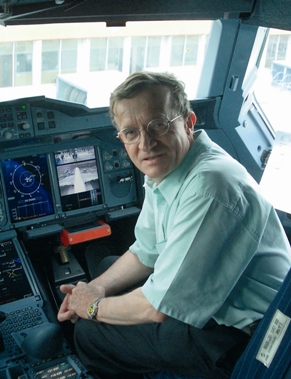Flight International A380 flight test update Part 3: By 25 August, the first Airbus A380, MSN001, had completed 72 flights and logged 247h since its first flight on 27 April, although including touch-and-gos, the actual number of approaches is closer to 100, says Airbus vice-president flight test Fernando Alonso.
A total of 20 Airbus and two European Aviation Safety Agency (EASA) test pilots have flown the aircraft, performing at least one take-off and landing, leaving only “three or four very young pilots” from the Airbus flight test department yet to get behind the controls, says chief test pilot Jacques Rosay. So far 31 flight test engineers – again including two from EASA – have also been airborne. The first non-test pilots could get the chance to fly the aircraft later this month.
“For the first two to three weeks we had a quick look around the aircraft in terms of flight control,” says Alonso. “If the handling is not good, that’s the first thing you need to fix.” However, no significant handling problems were encountered and the scope of the test effort was quickly expanded.
The aircraft was stalled for the first time on its third flight, and has been stalled more than 250 times since. “The wing root stalls first – the stall is very conventional, with a nice nose-down effect,” says Rosay.
The team were initially alarmed when strain-gauge data suggested aerodynamic forces on the horizontal stabiliser had exceeded limits during stall recovery. It was eventually determined that the gauges had been calibrated wrongly, resulting in their readings being 40% too high, but not before the flight test team had needlessly developed a technique to unload the stall more gently.
Alonso says the early dispatch reliability of the aircraft has impressed the team.
“We did not ground the aircraft for any maintenance or ground test activities until 11 weeks after first flight,” he says. The fact that the prototype has been logging 60-70 flight hours a month “says a lot about the readiness and availability of the aircraft”, Alonso adds. “Since the Paris air show we have routinely been flying twice a day.”
Some changes, for example to the aircraft’s angle-of-attack protection system, have been needed, although this was “just a question of adjustment”, he says.
A major early focus was on the optimisation of flap and slat configurations for take-off, approach and landing. A “Configuration 3” set-up was identified to boost take-off performance under certain conditions, but it could not be determined whether the optimum flap setting was 26° or 29° without performing the VMU (minimum unstick) tests (Flight International, 26 July–1 August). As a result, the VMU tests were brought forward by six months, and led to the 26° setting being selected.
The VMU tests – performed at Istres air base – were not incident-free. During the first roll, the aircraft rotated around the specially designed tailskid and the rear fuselage struck the runway. “Within two to three runs we got smarter and it was better,” says Alonso.
The A380’s approach speed is about 4kt (7.4km/h) lower than anticipated, with the reference speed at maximum landing weight coming in at 138kt. By comparison, the A340-300’s VREF is 137kt and the A340-600’s 151kt.
During MSN001’s downtime in week 11, 800 “flow cones”, each 6cm (2.4in) long, were installed on the starboard wing and engine nacelles to enable Airbus aerodynamicists to visualise the airflow.
Various engine nacelle strake designs – intended to improve airflow over the wing at high angles of attack – were test-flown, but “the best configuration was the initial one determined in the windtunnel”, says Alonso.
Rapid progress in the test programme has meant some of the systems tests originally planned for aircraft MSN004 – due to be the second A380 to fly – are now being done using MSN001.
Two cruise performance evaluation flights have been flown so far, although the aircraft is far from representative of the final configuration, mainly because the engines are “not up to the good standard” and the aircraft has many drag-inducing probes and other protuberances required for flight testing, says Alonso. With these factors taken into account, “we found the performance of the aircraft to be where we expected it to be”.
Late last month the aircraft was flown at Mach 0.95 – just below the maximum operating Mach number. “We explored the high-Mach area in the transonic regime,” says Alonso. “The build-up in the level of buffet was very gradual and mild.”
Rosay says the buffet at high Mach numbers is “very similar to what it is in the normal flight envelope. We expected a slight decrease in roll efficiency – in fact that’s not the case”.
The A380 has still to be tested at its MMO of 0.96 – a speed that Rosay admits the team do not wish to attempt “more times than we need to” because it involves a tricky dive manoeuvre. “You have to reach the [Mach number] target, but you don’t want to exceed it,” he says. The A380 will typically cruise at M0.85-0.87.
The heaviest take-off achieved to date is 555t – 14t below the planned initial maximum take-off weight (MTOW). However, Alonso says it is planned to perform a take-off with MSN001 at the higher, 600t MTOW of the A380 Freighter in an effort to truncate the test programme for the cargo variant.
Other approaching test milestones are water-ingestion trials, due at the end of this month, and the maximum-energy rejected take-off test in February.
MSN004, which Champion says will be “much closer to the entry-into-service standard”, is due to be handed over to flight test this month and fly in October. It will be equipped with upgraded Rolls-Royce Trent 900 turbofans providing lower fuel consumption and noise and improved exhaust gas temperature margin.
“The stall is very conventional, with a nice nose-down effect”
ANDREW DOYLE/TOULOUSE
Source: Flight International























